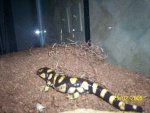trincan
New member
- Joined
- May 7, 2007
- Messages
- 53
- Reaction score
- 1
- Points
- 0
- Age
- 39
- Location
- Windsor, Ontario
- Country
- Canada
- Display Name
- Kara B
I am keeping my house at about 70 degrees (according to my thermostat, but it's old and drafty and cooler in some places than in others).
My tiger has been underground much of the time (in coco fiber kept moist)...I actually dug him up three weeks ago to make sure he is okay. I won't do that again because I feel this will upset him. I have put crickets in the enclosure, and when I tap on the screen with a worm, like I usually do, he doesn't come out anymore. He ALWAYS does, he is almost "conditioned", so to speak. Should I keep putting food in there? Most of the crickets are still in the cage. There are lots of hiding places, and this is pretty unusual behaviour. He is usually under his water bowl or in his cave, or under the sphagnum. The only thing I can think of is his biological clock wanting to hibernate. I am also throwing him around loosely-I have no idea if it is a male or female...he/she is a mean little buggar and snaps at anything that moves. I really don't want to be bitten, and when I made the boyfreind pick him up the sal lunged at him and he said NEVER AGAIN! Anyway, what is going on with my Tiger? anyone know?
My tiger has been underground much of the time (in coco fiber kept moist)...I actually dug him up three weeks ago to make sure he is okay. I won't do that again because I feel this will upset him. I have put crickets in the enclosure, and when I tap on the screen with a worm, like I usually do, he doesn't come out anymore. He ALWAYS does, he is almost "conditioned", so to speak. Should I keep putting food in there? Most of the crickets are still in the cage. There are lots of hiding places, and this is pretty unusual behaviour. He is usually under his water bowl or in his cave, or under the sphagnum. The only thing I can think of is his biological clock wanting to hibernate. I am also throwing him around loosely-I have no idea if it is a male or female...he/she is a mean little buggar and snaps at anything that moves. I really don't want to be bitten, and when I made the boyfreind pick him up the sal lunged at him and he said NEVER AGAIN! Anyway, what is going on with my Tiger? anyone know?


 Salamandra Enthusiast
Salamandra Enthusiast

